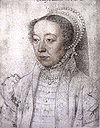Portal:Feminism/Selected article/18
Catherine de' Medici's building projects included the Valois chapel at Saint-Denis, the Tuileries Palace, and the Hôtel de la Reine in Paris, and extensions to the château, near Blois. Born in 1519 in Florence to an Italian father and a French mother, Catherine de' Medici was a daughter of both the Italian and the French Renaissance. She grew up in Florence and Rome under the wing of the Medici popes, Leo X and Clement VII. In 1533, at the age of fourteen, she left Italy and married Henry, the second son of Francis I and Queen Claude of France. On doing so, she entered the greatest Renaissance court in northern Europe. King Francis set his daughter-in-law an example of kingship and artistic patronage that she never forgot. She witnessed his huge architectural schemes at Chambord and Fontainebleau. She saw Italian and French craftsmen at work together, forging the style that became known as the first School of Fontainebleau. Francis died in 1547, and Catherine became queen consort of France. But it wasn't until her husband King Henry's death in 1559, when she found herself at forty the effective ruler of France, that Catherine came into her own as a patron of architecture. Over the next three decades, she launched a series of costly building projects aimed at enhancing the grandeur of the monarchy. During the same period, however, religious civil war gripped the country and brought the prestige of the monarchy to a dangerously low ebb.

